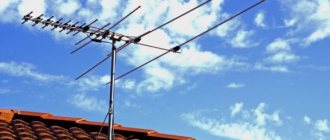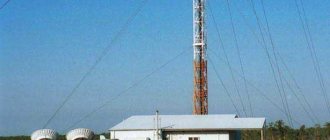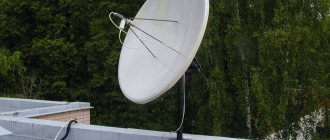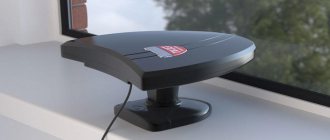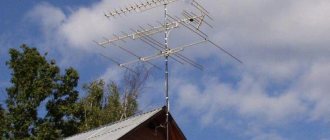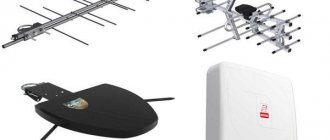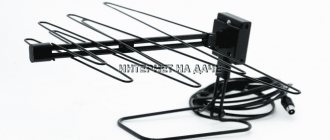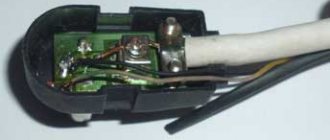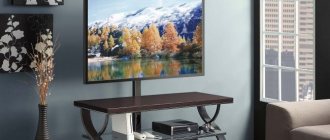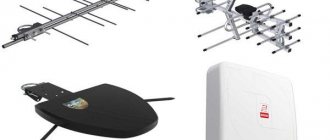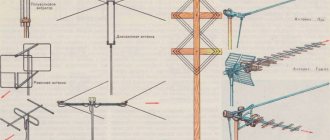In this material we will talk about what type of television antenna is optimal depending on the reception conditions, what you should pay attention to when choosing a specific model, and how not to fall for the advertising slogans of unscrupulous sellers. The material is divided into two parts, in the first we will consider general issues that are relevant to all people planning to purchase an antenna, and the second part will be more focused on technically savvy users and lovers of experiments.
The material is based on recommendations received from practitioners whom we asked to answer a number of questions regarding antenna selection. In addition to specialists from manufacturing companies and integrators, we also involved participants in the Telesputnik forum, among whom there are many experienced practitioners, in the discussion.
To make these answers understandable to non-specialists, let’s preface them with a small educational program on antennas.
Types of home antennas
Here we will not talk about satellite television dishes or patch antennas for receiving a digital signal of the new DVB-T2 format. Let's look at the types of common products that are often used in everyday life.
There are often obstacles in the path of radio waves. A household television antenna is used for the subscriber to receive radio waves amplified by a repeater (TV tower). To get a high-quality signal, you have to look for a suitable device. Main characteristics - radiation pattern (directional pattern), gain (gain), operating frequency range.
For household purposes, highly directional and omnidirectional devices are used. If the antenna “looks” at the repeater, then the signal quality will be good. Range is also important, as is the gain of the device. Due to this characteristic, you can receive a high-quality signal from a distant TV tower.
The television frequency range is meter (MV) and decimeter (UHF) waves. The boundaries of the radio frequency band are determined by the standards in force in the country. The subscriber receives both analogue and digital signals either via cable using cable television operators, or via the air if there is an individual/collective narrow/broadband antenna.
Indoor and outdoor devices
An indoor antenna in the form of one or two telescopic rods, installed with the end in the antenna socket of a TV receiver, is something many people remember from childhood. The operating principle is also used in modern products.
Types of indoor devices:
- rod-shaped The design is made of solid or telescopic metal pins. The product is designed to receive signals in the meter range. Advantages - compactness; disadvantages - when setting up high-quality reception of one channel, interference appears on others;
- frame. The main element is a contour in the form of a frame, most often round in shape. This product operates in the UHF range. It is impossible to achieve a high-quality signal at a great distance from the repeater;
- combined. The design combines the two previous types - rods and frame.
An outdoor antenna provides a better signal, especially if it is located high above the ground. If there are many obstacles in the path of the radio signal, then the outdoor device for receiving electromagnetic waves must be installed higher. An antenna mast mounted on the roof will help. Highly raised products are especially important for residents of rough terrain where repeater signals do not directly reach.
Active and passive antennas
Using a product with an amplifier, you can get high-quality picture/sound for those subscribers who live far from the TV tower. An active antenna is used if the distance to the transmitter is up to 30 km, and there are obstacles in the signal path that scatter radio waves to suppress interference.
If there are several TV receivers in the house, you need to use a special tee to simultaneously supply video/audio to all devices. It is important to remember here that when the source signal is divided into separate receivers in dividers and cables, some power is lost. In case of large losses, a more powerful antenna must be installed. Although it is possible that it is also impossible to do without amplification.
It is best to use a passive outdoor antenna, which is usually used in an area with good reception, and place the TV antenna amplifier in the house to avoid interference during bad weather/thunderstorms.
Table 1. Antenna selection depending on the distance to the transmitting station
| Distance from the transmitter, km | Product gain, dB |
| 5–10 | 4–6 |
| 10–30 | 9–12 |
| Over 30 | 20–25 + additional amplifier |
Insufficient amplification or power of the product is indicated by poor-quality picture/sound. In this case, you will need a more powerful active or passive device plus an amplifier.
"Butterflies"
These antennas got their name because of their resemblance to the wings of these insects. Leading engineer of NPP OST Igor Nekrasov characterizes them as an analogue of a loop vibrator. They are distinguished by a low gain (Ku = 2.15 dBi (0 dBd) and high characteristic impedance (300 Ohms). These indicators indicate that “butterflies” require a 300/75 Ohm matching device to connect to the cable.
According to Igor Lukashev, the slang term “butterflies” combines a lot of designs, some of which can hardly be called antennas. The most successful design of this type is the Kharchenko antenna with a reflector (Fig. 3). Despite its short length, it has good parameters and allows you to receive a signal near a television tower. And at a great distance it can work as part of an antenna field of 4 or 8 pieces, but this option is more suitable for the military who need to quickly deploy a receiving system. It is irrational to use such a field for individual reception due to the large windage of the structure.
How to set up an indoor antenna
As mentioned above, simple products with a rod structure work in the meter range, and frame ones in the decimeter range. For high-quality signal reception at a sufficient distance from the transmitting station, it is better to use combined devices equipped with an amplifier.
Setting up a TV antenna
- Place the product as close as possible to the TV receiver so that there is a window opening nearby.
- First you need to adjust the image to stations broadcasting in the meter range. You need to extend/push in, change the angle between the telescopic rods until a position with a good picture and sound is found.
- To search for a high-quality image and audio track in the UHF range, you need to rotate the frame.
- If the product is equipped with an amplifier, use the control to set the desired gain, again selecting the position that provides the best picture/sound.
Although television equipment is constantly being improved, many users successfully use simple household outdoor/indoor antennas, active or passive.
Whether to lock the distribution panel - about some safety aspects
https://electrotorg.ru/elektromontazhnoe-oborudovanie/raspredelitelnye-shchity-shkafy-upravleniya/
The rules for the manufacture and operation of distribution boards for various purposes and with different contents are listed in GOST R 51628-2000. This standard is intended for both newly constructed public or multi-apartment buildings and individual buildings, as well as for existing housing stock.
"Three squares"
Opinions were divided regarding the effectiveness of the “three square” antenna. Vitaly Fenev considers it as a type of directional antenna, standing on the same level as VK and LPA. According to him, it also has a pronounced directional pattern, allowing for gain in one direction and suppression of side and rear lobes.
But Igor Lukashev believes that “three squares” were justified for amateur radio reception on short waves, but were not at all interesting for television. In terms of amplification, “three squares” are almost equal to a three-element “wave channel”, but their design is very fragile, which is why they are not suitable even for indoor use.
Igor Nekrasov believes that modifications of antennas of this type with a circular arrangement of squares can be used to receive TV on a moving object, such as a car or a river boat.
Forum member Vramor considers all variants of “butterflies” and “three squares” to be the lot of originals and “homemade” ones, since they have no advantages in terms of quality of reception over LPA and VK. Their differences from classic models mainly come down to the fact that they can be placed a little differently, especially when it comes to indoor antennas. For example, a Kharchenko antenna, zigzag and without a reflector, can be hung on a window curtain or window handle.
Terminology
GOST R 51628-2000 contains:
| Term | Definition |
| Apartment shield | |
| Group | Located in the apartment, used to connect a group of lines, the meter is located on the floor in the metering and distribution panel (URS) |
| Accounting-group | The meter is inside the switchboard, the device is located in the apartment |
| Floor panel | |
| Distribution | Serves to connect group devices located in apartments on this floor |
| Accounting and distribution | Using this panel, electricity supplied to apartments located on the floor is taken into account and distributed |
| Combined | With an additional compartment for low-current networks (for connecting a telephone, radio and television receivers, the Internet) |
| Chain | |
| Nourishing | From input to floor panel |
| Distribution | From floor to apartment units |
| Group | From the panel to the lines of electrical receivers - lighting devices, sockets, etc. |
Design
When operating switchboards, they are affected by heat, electricity, and possible mechanical damage, so they are made from materials that are resistant to these factors.
Material requirements
Class I devices in terms of the degree of protection against electric shock are made of metal, but it is possible to supplement them with other materials.
The housings or shells of class II products are made of slightly or moderately flammable materials that are resistant to ignition and, in terms of flammability, belong to the B1 group. Such shields are installed on/in non-combustible walls.
The insulating elements of devices of classes I and II, to which live parts are attached, must comply with GOST R 51321.3 in terms of resistance to ignition. Requirements for the heat resistance of class II housings or shells are specified in the same standard.
The material from which the shells of the two classes of shields are made is selected with resistance to impacts and other mechanical impacts with a force of 0.7 J, and class I housings must also be corrosion-resistant.
Design features
The housings or shells of the panels are made in the form of cabinets or drawers that are hung on the wall.
The housing component can only be removed if you use a special tool.
The strength of screw fasteners when installing removable elements is in accordance with the requirements of GOST R 51321.3.
You need to know to install the shield: regardless of the installation method - hanging or embedding in a niche, the shields are equipped with elements with which they are attached to the wall surface.
Apartment and floor-type devices that are built into a niche are framed with structures that cover the protruding edges of the wall.
All electrical elements located inside the panels must be placed in such a way that it is possible to freely insert external cables and connect devices to switching terminals.
"Pins"
“Whip” antennas are mainly used to receive radio stations in the FM range, said experts interviewed by Telesputnik. With the advent of broadcasts in DVB-T/T2, otherwise than an analogue reacting to reflected signals, “pins” began to be used for receiving digital television in a car. However, in this case, when driving in the city, the signal may periodically disappear.
Igor Nekrasov (NPP OST) draws attention to another important factor: the “pin” has vertical polarization, and TV, as a rule, broadcasts in horizontal polarization. Therefore, this design allows the reception only of signals whose polarization has changed due to reflection from a surface or as a result of other distortion. Therefore, it is not surprising that antennas for cars are more often L-shaped.
Do I need to lock the shield?
The door of the switchgear housing must move without jamming and open freely at an angle of more than 95°, but not less. Access to internal electrical equipment should be convenient both during hardware installation and during maintenance.
Apartment panels with automatic circuit breakers (automatic switches) can be produced by the manufacturer without doors, if this is agreed with the consumer.
The operating panel with the output of the control elements is located behind the door and blocks access to internal live parts.
The doors of apartment and floor distribution devices must be locked with a key. If the panel is located in an apartment and is equipped with automatic machines, then locking is not necessary.
At the request of the consumer, additional hatches with lockable doors and access to the control elements of the equipment separately for all apartments on the floor are made in floor distribution devices (metering, group).
If there are no doors in an apartment panel equipped with automatic switches, the operating panel must be resistant to mechanical damage and impacts applied with a force of 0.7 J.
Doors that cannot be locked with a key are equipped with devices that prevent accidental opening.
Low-current devices that are located in a separate compartment of the distribution panel behind a metal partition must be shielded. In addition, a metal partition, whose thickness is indicated in the design documentation, also serves as fire protection. This compartment is equipped with a separate key-locked door.
To prevent unauthorized access to electricity meters, apartment and floor switchgears are equipped with design elements that can be sealed. In shields located on the floor, seals are placed on the doors.
Switchgears in which meters are installed are equipped with transparent windows located above them, the material for the manufacture of which must be impact-resistant.
